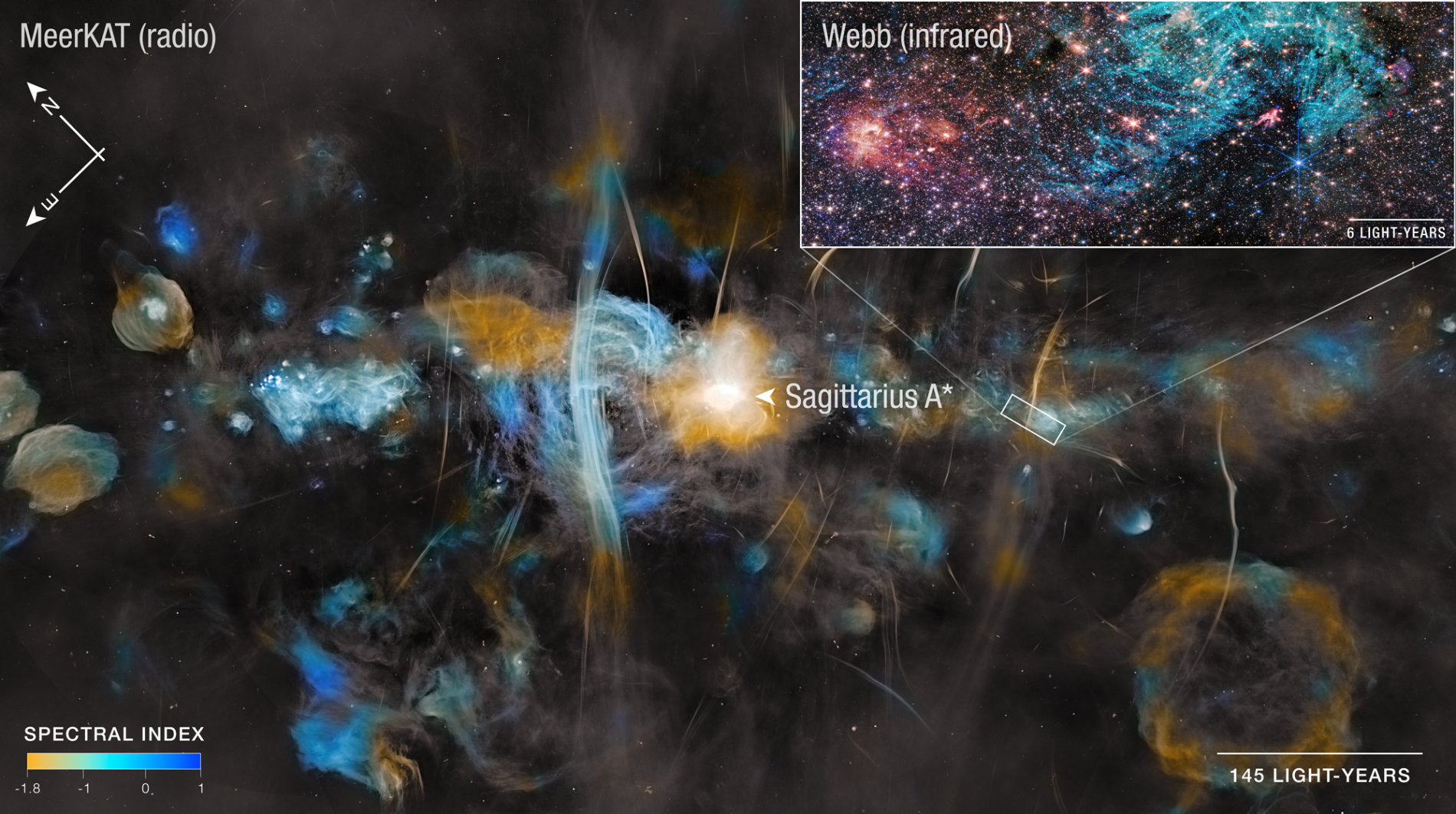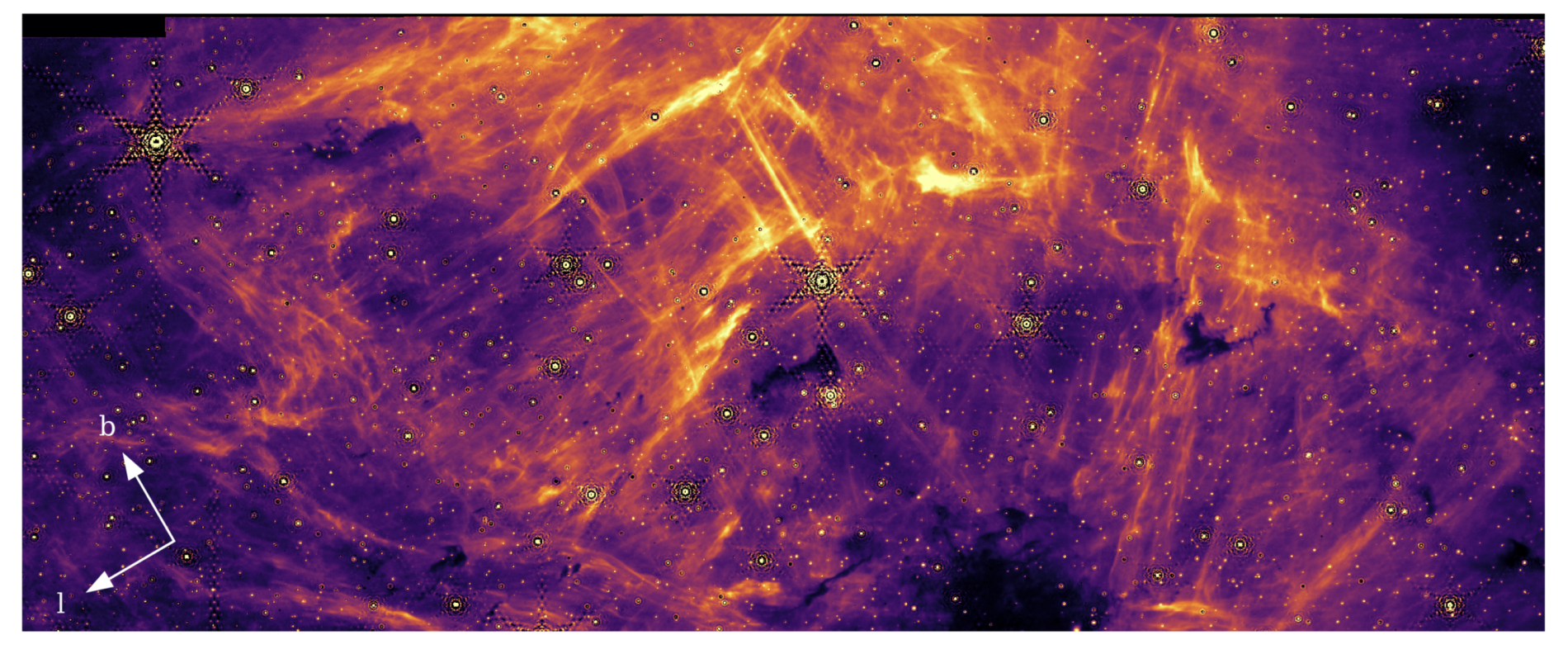The James Webb Telescope reveals how stars form in one of the most extreme regions of our galaxy
Two studies co-led by the Instituto de Astrofísica de Andalucía (IAA-CSIC) have examined the center of our galaxy with unprecedented detail, thanks to observations from the James Webb Space Telescope
The findings could help clarify why star formation in one of the innermost regions of the Milky Way is surprisingly low despite having conditions that should favor this process
The centre of our galaxy is an extreme environment where intense cosmic phenomena transform space and matter. In one region of the galactic centre, located about 200 light-years from Sagittarius A* - the supermassive black hole at the centre of the Milky Way - there is a huge, dense cloud of interstellar gas and dust. Over millions of years, this cloud has collapsed in on itself, leading to the formation of thousands of new stars. This region is known as Sagittarius C.
Two new papers, co-led by the Instituto de Astrofísica de Andalucía, have used observations from the James Webb Space Telescope (JWST), jointly built and operated by the European Space Agency (ESA), the Canadian Space Agency (CSA) and NASA, to study Sagittarius C in unprecedented detail.
"The main goal of these observations was to study the star formation processes of massive stars, i.e. those with more than eight times the mass of the sun," says Rubén Fedriani, a researcher at the Instituto de Astrofísica de Andalucía and lead supervisor of the project. "In their early stages of formation, stars usually present jets of matter or jets. In this work we have detected more than a hundred jets linked to low-mass protostars, similar to our star. In addition, we have observed for the first time in the infrared the jets associated with two massive stars, about 20 times the mass of the Sun."
Thanks to this jet activity, the study has also discovered a new region of star formation. This discovery suggests that star formation in this region follows similar processes to those in the rest of the galaxy, showing that even in environments as extreme as the centre of the Milky Way, new stars can be born.
The findings could also help solve a persistent mystery about the innermost regions of the Milky Way, known as the Central Molecular Zone (CMZ), which encompasses Sagittarius C and other star-forming regions. This zone is characterised by large amounts of dense molecular gas, making it one of the regions with the highest potential for new star formation in our galaxy. However, despite its high gas density, the rate of new star formation in the CMZ is lower than predicted by models, which has led to numerous investigations to understand the physical processes that regulate this activity.
The work, co-led by the University of Colorado Boulder, the University of Virginia and the Instituto de Astrofísica de Andalucía, has observed evidence of magnetic field lines running through Sagittarius C, forming long, glowing strands of hot hydrogen gas that resemble spaghetti noodles. This phenomenon could cause star formation in the surrounding gas to slow down.

MeerKAT and James Webb Space Telescope images of the star-forming region Sagittarius C, about 200 light-years from the Milky Way’s central supermassive black hole, Sagittarius A*. Huge vertical filamentary structures in the MeerKAT radio data echo those Webb captured on a smaller scale, in infrared, in a blue-green hydrogen cloud. Astronomers think the strong magnetic fields in the heart of the galaxy are shaping the filaments. Credits: NASA, ESA, CSA, STScI, SARAO, Samuel Crowe (UVA), John Bally (CU), Ruben Fedriani (IAA-CSIC), Ian Heywood (Oxford)
MAGNETIC FIELDS: THE IMPACT OF THE UNEXPECTED STRUCTURE OF SAGITTARIUS C
The first study, published in The Astrophysical Journal, is part of an observational campaign proposed and led by Samuel Crowe, a fourth-year student at the University of Virginia who, during the summer of 2023, worked at the IAA-CSIC together with Rubén Fedriani, second author and principal supervisor of the work. Crowe, who was recently awarded a Rhodes Scholarship for postgraduate studies at Oxford University, points out that the striking images captured by JWST show Sagittarius C as it has never been seen before.
"These magnetic fields give Sagittarius C an appearance unlike any other star-forming region in the galaxy outside the galactic centre," explains Crowe.
A second study, published in the same journal, analysed the unusual appearance of Sagittarius C and revealed a stark contrast to both the Orion nebula and many others in our galaxy, which look mostly uniform. In this region of the galactic centre, dozens of elongated, glowing filaments emerge, some several light-years long. These structures are composed of plasma, a hot, particle-laden gas.
"We definitely didn't expect these filaments," says Rubén Fedriani (IAA-CSIC), co-author of the study. "This discovery has been a serendipity."

Filaments found in the region of the galactic centre Sagittarius C. Credits: Bally, J,. Crowe, S., Fedriani, R. et al 2025, ApJ
The research suggests that magnetic fields play a crucial role in both the origin of Sagittarius C's elongated structures and its star formation. At the centre of the galaxy lies Sagittarius A*, a supermassive black hole with a mass roughly four million times that of the Sun. The gas swirling around it stretches and amplifies nearby magnetic fields, which, in turn, shape the plasma in Sagittarius C.
John Bally, a professor in the Department of Astrophysical and Planetary Sciences at the University of Colorado Boulder, suspects that other star-forming regions, such as the Orion Nebula, appear much more uniform because they are in a much weaker magnetic environment.
Scientists have long known that the innermost regions of the galaxy are important stellar nurseries. However, some calculations have suggested that this region should be producing many more young stars than have been observed. In the Central Molecular Zone, magnetic fields may be strong enough to resist the gravitational collapse of molecular clouds, limiting the rate of new star formation. "We have theorised that all such regions in the centre of our galaxy have a filamentary structure due to the strong magnetic fields of the galactic core," explains Fedriani (IAA-CSIC). ‘However, this hypothesis will have to be confirmed by future observations with the James Webb Telescope.
However, Sagittarius C's time may be coming to an end. The stars in the region have already dispersed much of their molecular cloud, and this stellar cradle could disappear completely in a few hundred thousand years.
These active star-forming sites also cause their own destruction. As new stars grow, they begin to emit huge amounts of radiation into space. This radiation, in turn, blasts out the surrounding material, depriving the region of the matter needed to create more stars. "Even the Sun, we believe, formed in a massive cluster like this," says Bally (University of Colorado Boulder). "Over time, over billions of years, all of our sister stars have dispersed."
- Article 1: The JWST-NIRCam View of Sagittarius C. I. Massive Star Formation and Protostellar Outflows
- Article 2: The JWST-NIRCam View of Sagittarius C. II. Evidence for Magnetically Dominated HII Regions in the Central Molecular Zone
- JWST press release - https://webbtelescope.org/contents/news-releases/2025/news-2025-115
- Rubén Fedriani - fedriani@iaa.es
- Instituto de Astrofísica de Andalucía (IAA-CSIC)
- Unidad de Divulgación y Comunicación
- Amanda López – alm@iaa.es
- Emilio García – garcia@iaa.es - 649 407 445 (vía whatssap)
- Celia Navas - navas@iaa.es
- https://www.iaa.csic.es
- https://divulgacion.iaa.csic.es

